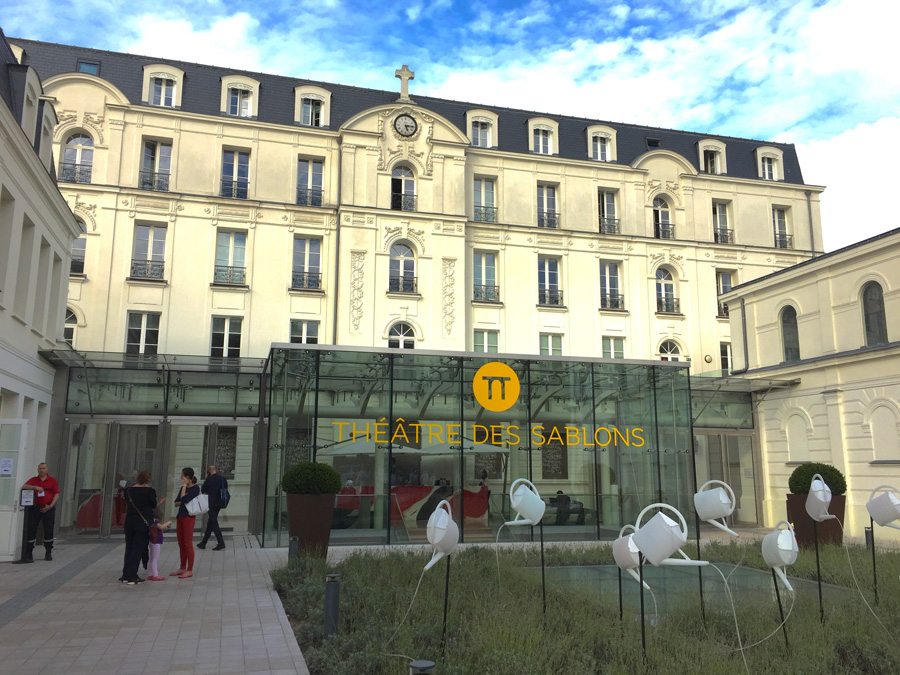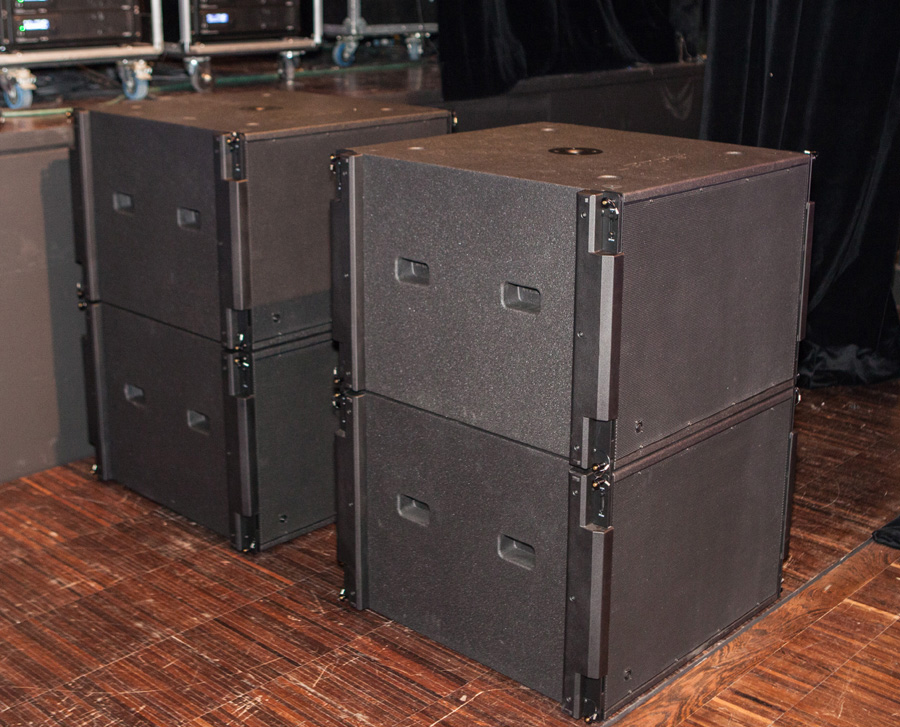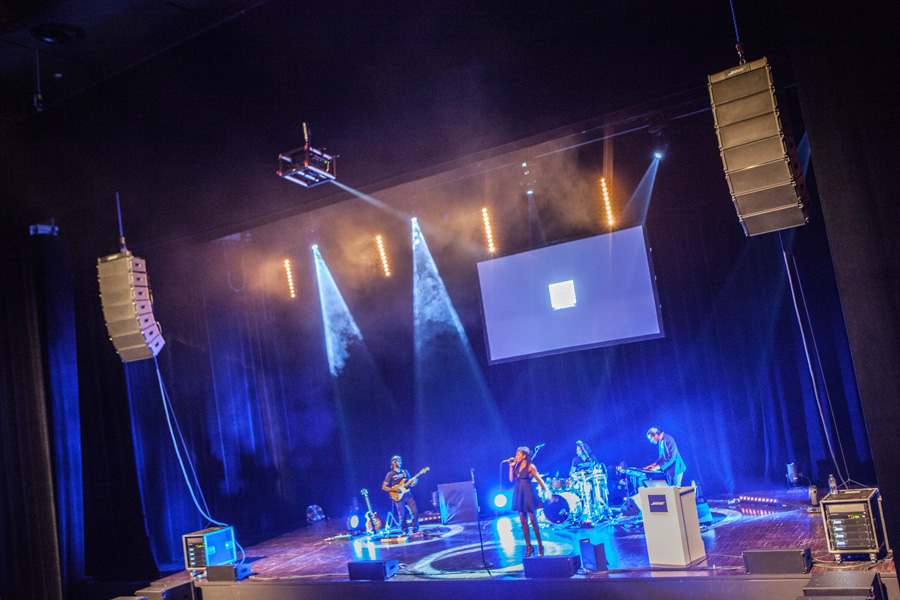

We know about RoomMatch, Bose’s system with constant-curvature and DeltaQ technology designed for flexible vertical and horizontal coverage.
Now we have ShowMatch, a new system that gives even more with mechanical optimization provided by DeltaQ coverage but also offers the possibility of working with line source configurations, therefore allowing you to reach new “Show” markets where SPL, weight and dimensions really count.
A demonstration was organized in Paris by the American manufacturer. SLU was there and we’d like to share our first impressions. Congratulations to Sophie Molitor and the entire Bose Pro France team for truly perfect organization..
The petit fours were quickly eaten and we were able to see and appreciate the design, transducers and the materials via a static display of a number of enclosures.
For anyone that may have missed our coverage of the ShowMatch presentation during Infocomm 2016, let’s revisit the main characteristics of this new system.
ShowMatch in a nutshell

This two-way system consists of three enclosures (SM5, SM10 and SM20) and an SMS118 subwoofer of the same width, allowing for ground stack or array positions. The three enclosures differ in their vertical coverage (5, 10 or 20°) and their box shape at the back, meaning angles are even more refined and the load volume is slightly reduced.
In contrast to specialist systems, ShowMatch can be arrayed in constant curvature with boxes chosen based on vertical coverage desired and SPL sought based on distance. Variable curvature is also an option with the 5° coverage model, which has a rigging system that allows angles to be adjusted by 1° increments. This is a first for the American manufacturer, opening up the touring market for it in a big way. .


But if you’re talking about DeltaQ, you’re talking about the possibility of varying horizontal coverage as well. In contrast to RoomMatch, which as a perfect install product requires you to choose your coverage option at purchase, ShowMatch gains flexibility via its 4 interchangeable side panels that can be removed with the aid of four screws to change the horizontal directivity from 70 to 110°, with two kits shipped with each enclosure.
Don’t jump in and complain, the optional 55° and 120° panels offer an even greater number of combinations. Finally, as with other manufacturers, combining two coverage options is possible for asymmetric directivity. It suffices to say, virtually any application is possible with this system from small halls to live applications that are much more ambitious.

With regard to transducers, Bose has not overlooked quality and quantity, fully aware that live applications requires close attention to SPL. The proof is in the peak values of 127 dB (low frequency) and 132 dB (high frequency) for the SM5 model.
To reach these levels, in spite of its small size and very modest weight of around 30 kg, the old RoomMatch drivers have been improved through modifications to their relatively low starting frequency. This is because the drivers only take over at 800 Hz with ShowMatch.
Now known as EMB2S, the drivers deliver 4 dB more than the previous model. Configured in four parallel series on the CADS (Continuous Arc Diffraction Slot) wave guide.



they work very well with the pair of 8’’ maximum-performance woofers, a 3’ voice coil and a neodymium magnet (which is made in Italy and beautifully manufactured). We will see its inner workings and its descending capacity for low frequencies later on. The 18’’ SMS118 bass reflex subwoofer also has high excursion and a neodymium magnet. It’s designed to be fitted at the top of a line or at the base of a line.
ShowMatch is equipped with a number of accessories and notably rigging that enables 24-enclosures hang with a 10:1 safety factor. For amplification, Bose offers two solutions. For install, the PowerMatch PM8500, a smart amplifier, is powerful and flexible like the range of speakers. It benefits from the ability to bridge the eight 500-watt channels that make it up (we will see how later on).

When it comes to touring, Bose has selected Powersoft, which needs no introduction. Bose will provide Powersoft with the presets necessary for the ShowMatch system.
Follow us through to the Sablons auditorium

After this brief presentation, we resume our afternoon of ShowMatch discovery in the theatre hall where Sophie Molitor, Manager of professional systems & live music at Bose France and Blaise Dupiellet, Manager of the engineering office at Bose France, are waiting for us. When it comes to decibels, we are in for a treat.

Seven boxes on the right and left-hand side, along with four subwoofers arrayed on the ground were deployed. This is the same system that is touring to European distributors and brand subsidiaries.

SLU : What type of box is hanged ?
Blaise Dupiellet : We have four 5° and three 10° enclosures to complete the line. On the edge of the stage, we have four 20° enclosures and eight subwoofers in groups of four in a cardioid array.
For amplification, we use PM8500 power amplifiers where we bridge two channel pairs and the remaining four are used for a parallel/bridge configuration (known as Quad mode), which allows you to reach 2000 W at 4 ohms.
Therefore, the amplifier divides into three channels: two 1000 W channels and one 2000 W channel. This powers enclosures pair in parallel and a subwoofer. The enclosures are 6 ohms for the high-frequency section and 8 ohms for the low-frequency section. The subwoofer is 4 ohms, so, it’s very comfortable.
SLU : The current presets are relatively straightforward..
Blaise Dupiellet : That’s thanks to standard filters, equalizers, delays and limiters. We have chosen a relatively flat response with an alignment that has essentially been carried out with console in mind. However, because our amplifiers are designed for install, Bose has reached an agreement with Powersoft to enable ShowMatch to travel around. This offers ShowMatch to benefit from a DSP platform that is more elaborate. We recommend the X4 and X8 for high-profile install and touring. The ShowMatch presets for Powersoft will be available when we have finalized the delivery package.

We also have a “shooter” for RoomMatch and ShowMatch, which is simple but effective and allows you to design a direct field quickly. This is the Bose Array Tool. The aim is to come up with a design in less than five minutes and to export a report with all the information required for setup. You can also make use of an option that suggests the number of enclosures needed based on coverage area.
Even more information with Arthur Boutin

We left Blaise Dupiellet to the rest of the integrators, technicians and clients present and took our multitude of questions to Arthur Boutin, a commercial technician with Bose who has a solid technical background. We asked him for some more precise details about the system.
SLU : The EMB2 drivers seem like a force to be reckoned with.
Arthur Boutin : They have been modified to accommodate the 8’’woofers. With RoomMatch they were working with six at a time but with two 10’’ woofers and they were going down to 500 Hz. ShowMatch’s cutoff frequency is set at 800 Hz, which gives the newly named EMB2s a better response for high frequencies and enables them to deliver 4 dB more from 8 to 16 kHz. This is essential for a line-array and prevents too much boost in the presets.

SLU : : Is there a total of four set of panels that modify the horizontal coverage of the boxes?
Arthur Boutin : Each enclosure has its directivity that will be included with delivery. For example with the SM5, we fit a 70° set of panels at the factory but you can fit a second option or even a third depending on what you include in the shipping box. To sum up, the SM5 is compatible with 55°, 70° and 100°, the SM10 is compatible with 70° and 100° and the SM20 is compatible with 70°, 100° and 120°. So you have eight possibilities in total.
The preset is the same for the eight directivity variants. You can also combine two different coverages to avoid, for example, hitting a horizontal wall or even a catwalk that an artist with a microphone in his hand is using. With regard to directivity, you must be thorough in your work. You can’t change from one 55° box to a 120° one. Modeler is really helpful for seeing whether or not combinations of different models work.

SLU : How are the two 8’’ woofers loaded?
Arthur Boutin : The unique nature of this enclosure is in the distribution of the entire load volume between the two transducers. This gives a fairly wide response for low frequency. It’s only really the waveguide and the four drivers that take up much space. RoomMatch used to distribute the volume in two parts and the drivers were separate.
SLU : Anything to add about the subwoofer?
Arthur Boutin : It was developed at the same time as ShowMatch and uses the same dimensions meaning that you can use it in any way for ground stack or array positions. Bose made sure that a Speakon was fitted on the front side to facilitate cardioid arrays.

SLU : And the woofer?
Arthur Boutin : A super 18-inch one manufactured in Italy based on Bose specifications. It has a huge excursion and neodymium magnet, which gives it, amongst other things, a modest weight.
SLU : I’m going to ask this question again because we feel that there is unearthed potential in this system. What is the status of the presets?
Arthur Boutin : Today, we have presets that are defined but we know that this software lives with the system and its users, so it’s going to change.

SLU : All line-array systems need a software platform.
Arthur Boutin : Our platform is Modeler, a powerful electro-acoustic simulation tool that is the equivalent of Ease and CATT. As an example, it considers venue materials and acoustic characteristics as well as complex shapes. Knowing that install and touring can’t be treated in the same way, we decided to create a tool that was more straightforward, intuitive and quick to use. We called it Bose Array Tool and it operates based on Modeler with the same design tools.
SLU : Let’s go back to install. Do you have any variants of ShowMatch dedicated to this market?
Arthur Boutin : No. ShowMatch is designed with both install and touring in mind. For this reason, the two rear transport carrying handles and the flanks, which have two other molded handles, may be removed. The same goes for the pins that are designed for touring. These have been replaced by smaller and shorter models. All of this allows you to gain space and gives the boxes an even more discreet design.

SLU : I can only see a splay mechanism on the SM5s
Arthur Boutin : That’s normal. This model will essentially be the one used for touring and speaker arrays. We offer from 0 to 5° by increments of 1°. The SM10s and SM20s will be mainly installed with a DeltaQ constant-curvature. Attaching these with short pins is enough. Talking of the pins, the touring pins have a slider to hold them in place and they slide really well (laughs).
SLU : What materials are used for your enclosures?

Arthur Boutin : Baltic birch plywood for the enclosure, steel for the rigging system and polymer makes up the rest for greater lightness. The advantage of using this type of wood is its resistance to water and temperature changes. The system is resistant to light rain but that being said, we don’t have enough information to be able to judge how it will hold out over time.
SLU : The back of the panels that vary directivity seem well thought through…
Arthur Boutin : They are. They reduce certain interferences from the 8’’. They also modify and optimize polar response.
SLU : Do you have an idea of when ShowMatch will be available for purchase?
Romain Gamundi (Marketing & Events Coordinator for Bose) : Ok, I’ll answer that. Everything should be available at the start of December 2016.
SLU : Any idea of pricing?
Romain Gamundi : The three enclosures will have the same price of €3,850 before tax and the subwoofer will be €3,400 before tax. The extra panel (both sides) will be sold for €110, and finally the large frame will be €2,950 before tax. This pricing is about 30% lower than the best-known brands and it allows you to use the system in three ways.
For example, with three SM20s with either a 70° or 100° horizontal directivity, you have a point source system that is both affordable and powerful. By combining more enclosures and directivity, you have a full DeltaQ system with all of its advantages for install, but with more SPL and a smaller size than with RoomMatch.
Finally, by using the SM5 and SM10 enclosures with variable curvature, you can easily reach 50 to 60 meters, throwing sound for large events. Take clubs for example, you can equip the smallest and the biggest by taking advantage of our new subwoofers, which go down to 32 Hz.
An excellent choice by Bose
SLU : Are you able to provide complete touring configurations with the amplifiers?

Blaise Dupiellet : Of course. In addition to 100% Bose install configurations, we will be selling touring racks specifically designed for ShowMatch and equipped with Powersoft amplifiers . There is a Belgian company that deals with assembly of products based on our specifications.
A word with an elusive man
We finally had a chance to talk to Akira Mochimaru, the General Manager of the Professional Systems Division at Bose Corporation, a man who is rarely seen on French shores. We asked him why Powersoft was chosen for touring amplifiers.

Akira Mochimaru : PowerMatch is an excellent amplifier. It’s very robust and, quite simply, I’m sure that it can take to the road. It’s just that it is configured for install with Euroblock connecters, which aren’t suitable for touring.
Rather than setting strict guidelines, we have decided to allow users to freely use other models, especially Powersoft, which is an excellent brand that is reliable and offers high-quality products.
In addition, they have a very good network of distributors that provide after-sales service. Finally our agreement includes access to their DSP platform where we can integrate our presets and remote control of the system.
I’d like to stress that we’re not saying that people have to use Powersoft amplifiers, but it is true to say that we haven’t tested or approved other brands. On the other hand, trials that have been carried out in Bose laboratories with the Italian brand have been very convincing.
Conclusion and listening
Brave and, some would say, daring. With ShowMatch, Bose is throwing itself into the deep end of line array with the aim of considerably extending its usage range through its DeltaQ technology. Bose also benefits greatly with the smart choice of Powersoft to provide power and advanced features that are vital in attracting clients from the touring sphere.
Hearing the system in action strengthened our positive first impressions from the very first notes. With mastered music, the high frequency and medium frequency appear exact and pleasant, prolonging a low frequency that is interesting and sufficiently edgy where the connection with the subwoofers flows nicely with the exception of a small loss of impact, at least in the hall where we had our brief listen. On the other hand, the lone enclosures have an attack and interesting playback with low frequencies, ideal at low levels and for vocal groups.
Listening to the live mix from the band playing especially for Bose improved our impressions. Voices were reproduced with clarity and definition, without sounding rough. The same goes for the instruments, drums and keyboards alike. The playback truly is “live” combining the punch and color you need to bring in large audiences. The feeling of power is very apparent thanks to pressures ranging from 100 to 102 dB(A), which seemed more than enough to us.

On the other hand, I did notice a few little details that could be adjusted with regard to polar coverage. The system’s mono summation leaves room for improvement and the classic bump at the 0° point of the enclosures needs to be smoothed out. It can’t be denied that the hall is partly responsible for this and 12-meter distance between the hangs isn’t ideal for a room that is quite small overall.
Also, let’s not forget that we listened to a system that’s filtered with good old Butterworth, when the competition works with FIR and that no improvement was made via the DSPs. So, I’m very eager to hear ShowMatch again when it’s equipped with Powersoft and particularly when driven by the specific presets allowing it to benefit from the processing power that these amplifiers possess. Also, I’m eager to hear refined polar audio, which will lead to longer lines and an even more in-your-face sound. Also, maybe these new presets will take the various possibilities for symmetrical or asymmetrical coverage into account.

When all is said and done, ShowMatch is undoubtedly well conceived from a mechanical and acoustic point of view and with the work that will be carried out based on consumer feedback, it will establish itself in its professional landscape.









